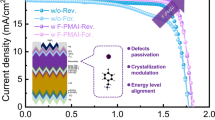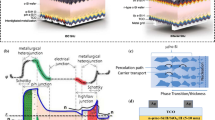Abstract
Boron-oxygen defects can cause serious light-induced degradation (LID) of commercial solar cells based on the boron-doped crystalline silicon (c-Si), which are formed under the injection of excess carriers induced either by illumination or applying forward bias. In this contribution, we have demonstrated that the passivation process of boron-oxygen defects can be induced by applying forward bias for a large quantity of solar cells, which is much more economic than light illumination. We have used this strategy to trigger the passivation process of batches of aluminum back surface field (Al-BSF) solar cells and passivated emitter and rear contact (PERC) solar cells. Both kinds of the treated solar cells show high stability in efficiency and suffer from very little LID under further illumination at room temperature. This technology is of significance for the suppression of LID of c-Si solar cells for the industrial manufacture.
Similar content being viewed by others
References
Bothe K, Hezel R, Schmidt J. Recombination-enhanced formation of the meta stable boron–oxygen complex in crystalline silicon. Applied Physics Letters, 2003, 83(6): 1125–1127
Fischer H, Pschunder W. Investigation of photon and thermal induced changes in silicon solar cells. In: Proceedings of the 10th IEEE Photovoltaic Specialists Conference. Alto P, Calif, 1974, 404–411
Lim B, Hermann S, Bothe K, Schmidt J, Brendel R. Solar cells on low-resistivity boron-doped Czochralski-grown silicon with stabilized efficiencies of 20%. Applied Physics Letters, 2008, 93(16): 162102
Bothe K, Sinton R, Schmidt J. Fundamental boron-oxygen-related carrier lifetime limit in mono and multicrystalline silicon. Progress in Photovoltaics: Research and Applications, 2005, 4(13): 287–296
Schmidt J, Bothe K. Structure and transformation of the meta stable boron-and oxygen-related defect center in crystalline silicon. Physical Review B: Condensed Matter and Materials Physics, 2004, 69(2): 024107
Voronkov V V, Falster R. Latent complexes of interstitial boron and oxygen dimers as a reason for degradation of silicon-based solar cells. Journal of Applied Physics, 2010, 107(5): 053509
Schmidt J, Aberle A G, Hezel R. Investigation of carrier lifetime instabilities in Cz-grown silicon. In: Proceedings of the 26th IEEE Photovoltaic Specialists Conference. Anaheim, 1997
Herguth A, Schubert G, Kaes M, Hahn G. Investigations on the long time behavior of the metastable boron-oxygen complex in crystalline silicon. Progress in Photovoltaics: Research and Applications, 2008, 16(2): 135–140
Glunz S W, Rein S, Warta W, Knobloch J, Wettling W. Degradation of carrier lifetime in Cz silicon solar cells. Solar Energy Materials and Solar Cells, 2001, 65(1–4): 219–229
Yoshida T, Kitagawara Y. Bulk lifetime decreasing phenomena induced by light-illumination in high-purity p-type CZ-Si crystals. In: Proceedings of the 4th International Symposium on High Purity Silicon IV, 1996, 450–454
Glunz S W, Rein S, Knobloch J, Wettling W, Abe T. Comparison of boron and gallium doped p-type Czochralski silicon for photovoltaic application. Progress in Photovoltaics: Research and Applications, 1999, 7(6): 463–469
Yu X, Wang P, Chen P, Li X, Yang D. Suppression of boron-oxygen defects in p-type Czochralski silicon by germanium doping. Applied Physics Letters, 2010, 97(5): 051903
Wu Y, Yu X, He H, Chen P, Yang D. Suppression of boron-oxygen defects in Czochralski silicon by carbon co-doping. Applied Physics Letters, 2015, 106(10): 102105
Herguth A, Schubert G, Kaes M, Hahn G. Avoiding boron-oxygen related degradation in highly boron doped Cz silicon. In: Proceedings of the 21st European Photovoltaic Solar Energy Conference, 2006, 530–537
Lim B, Bothe K, Schmidt J. Deactivation of the boron-oxygen recombination center in silicon by illumination at elevated temperature. Physica Status Solidi (RRL)-Rapid Research Letters, 2008, 2(3): 93–95
Lim B, Bothe K, Schmidt J. Impact of oxygen on the permanent deactivation of boron-oxygen-related recombination centers in crystalline silicon. Journal of Applied Physics, 2010, 107(12): 123707
Lim B, Liu A, Macdonald D, Bothe K, Schmidt J. Impact of dopant compensation on the deactivation of boron-oxygen recombination centers in crystalline silicon. Applied Physics Letters, 2009, 95(95): 232109
Wilking S, Herguth A, Hahn G. Influence of hydrogen on the regeneration of boron-oxygen related defects in crystalline silicon. Journal of Applied Physics, 2013, 113(19): 194503
Lim B, Bothe K, Schmidt J. Accelerated deactivation of the boronoxygen- related recombination centre in crystalline silicon. Semiconductor Science and Technology, 2011, 26(9): 95009–95011(3)
Herguth A, Hahn G. Towards a high throughput solution for boronoxygen related regeneration. In: 28th European Photovoltaic Solar Energy Conference and Exhibition, 2013, 1507–1511
Bothe K, Schmidt J. Fast-forming boron-oxygen-related recombination center in crystalline silicon. Applied Physics Letters, 2005, 87(26): 262108
Hashigami H, Dhamrin M, Saitoh T. Characterization of the initial rapid decay on light-induced carrier lifetime and cell performance degradation of Czochralski-grown silicon. Japanese Journal of Applied Physics, 2003, 42 (Part 1, No. 5A): 2564–2568
Inglese A, Lindroos J, Savin H. Accelerated light-induced degradation for detecting copper contamination in p-type silicon. Applied Physics Letters, 2015, 107(1): 41–46
Lindroos J, Yli-Koski M, Haarahiltunen A, Savin H. Roomtemperature method for minimizing light-induced degradation in crystalline silicon. Applied Physics Letters, 2012, 101(23): 232108
Lindroos J, Savin H. Formation kinetics of copper-related lightinduced degradation in crystalline silicon. Journal of Applied Physics, 2014, 116(23): 234901
Bothe K, Schmidt J. Electronically activated boron-oxygen-related recombination centers in crystalline silicon. Journal of Applied Physics, 2006, 99(1): 013701
Fertig F, Krauß K, Rein S. Light-induced degradation of PECVD aluminium oxide passivated silicon solar cells. Physica Status Solidi (RRL)-Rapid Research Letters, 2015, 9(1): 41–46
Author information
Authors and Affiliations
Corresponding author
Rights and permissions
About this article
Cite this article
Xie, M., Ren, C., Fu, L. et al. An industrial solution to light-induced degradation of crystalline silicon solar cells. Front. Energy 11, 67–71 (2017). https://doi.org/10.1007/s11708-016-0430-x
Received:
Accepted:
Published:
Issue Date:
DOI: https://doi.org/10.1007/s11708-016-0430-x




